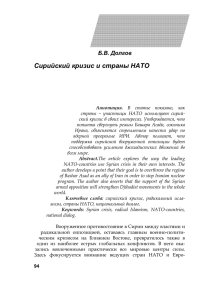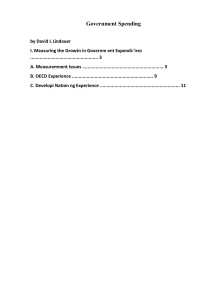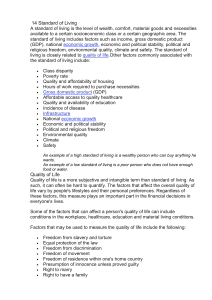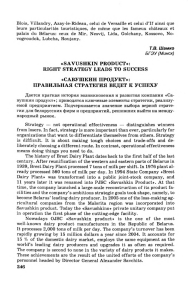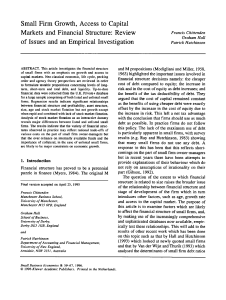(2015 (estimate), %)
реклама
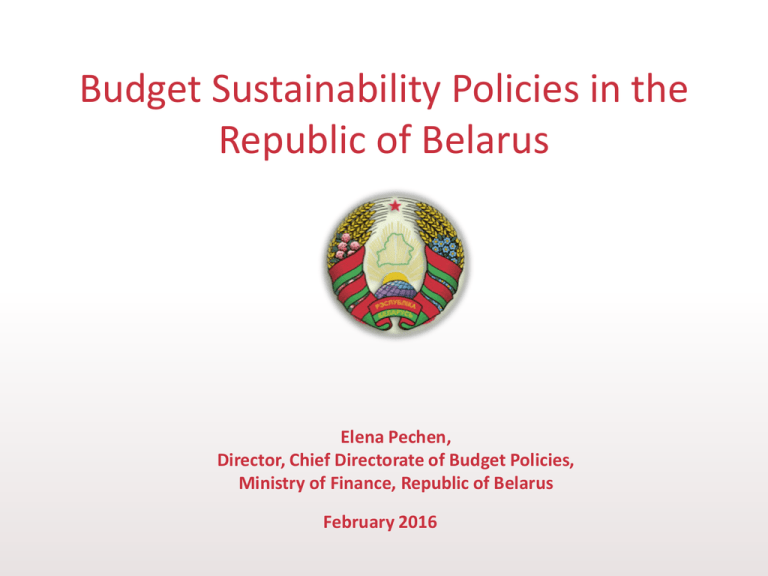
Budget Sustainability Policies in the Republic of Belarus Elena Pechen, Director, Chief Directorate of Budget Policies, Ministry of Finance, Republic of Belarus February 2016 Background Form of Government: presidential republic Population: 9.5 million people (men – 46.5%, women – 53.5%; urban residents – 77.3%, rural population – 22.7%) Capital: Minsk – 1.9 million people State Languages: Byelorussian, Russian Open, export-oriented economy: Belarus sells its goods in the markets of 161 countries Key trading partners in 2015: Russia – 48.3% 48.3% of total trade, EU countries – 25.3%, other countries– 26.4% Belarus Economy Currency Byelorussian Rouble (BYR) GDP US$76.2 billion (2014), per capita- US$6,600 (2014) GDP growth rate 101.7%(2012), 101.0%(2013), 101.7% (2014), 96.1% (2015, projected) Inflation (percentage change on previous year) 59.2% (2012), 18.3% (2013), 18.1% (2014), 13.5% (2015 projections) Human Capital Development Index High Level Development Group of Countries- 0.798 (50th position in global ranking) International Comparisons Centralization Rate (central government budget as % of GDP) GDP per capita (US$ thousand) Б&Г Украина Албания 70 58.4 60 53.6 52 50.1 50 46.4 44.6 50 40.6 40.3 38.8 37.5 35.6 34.1 33.5 40 30.9 17.7 30 14.3 13.7 12.7 11.0 20 8.4 6.6 6.6 3.5 2.1 1.2 10 0 Россия 41.3 Беларусь 45.0 40.0 35.0 30.0 25.0 20.0 15.0 10.0 5.0 0.0 National Debt as of the end of 2014, % of GDP The World Bank Doing Business Rankings (June 2015) Германия Lithuania Latvia Poland Armenia Kazakhstan Belarus Russia Greece Kirgiz Rep Ukraine Greece 15 France 20 22 25 51 60 Poland 50 Lithuania 41.1 80 22.3 Russia 83 60 68 Belarus 67 40 75 Ukraine 41 44 20 95 Germany 35 0 177 100 Maastricht Criterion – 60% 11 0 50 100 150 200 Social and Economic Development Priorities in the Budget Sector 1. Maintenance of optimal tax burden for the economy 2. Tax policy harmonization in EEU countries 3. Support of sustainable and well-balanced republican and local budgets through financing of expenditures within the available limits of revenues and sources of funding for budget shortfall (surplus) 4.Reduction of external national debt and improvement of government debt management efficiency while retaining its size, structure and debt servicing and repayment at safe levels to exclude excessive pressures. 5. Keeping the social sector of budget expenditures in place, prioritizing health and education sectors aimed at the improvement of health indicators and further development of education process. 4 Background for Introduction of Budget Rules 1. Establishment of stable environment for businesses, with regard to aggravating external economic factors 2. Promotion of investment opportunities of the economy and support of stability of its tax legislation. 3. Government guarantees of the minimal social service standards to the citizens, retention of social sector in budget spending 4. The time for peak in the national debt repayments, significant pressure on the budget to support the national debt repayment and servicing 5. Debt instability of individual local budgets providing a negative impact on macroeconomic balance 5 Consolidated Budget Revenues Revenues (2015 (estimate), %) Revenues (2016 (approved), %) Other revenues1 2.5% Other revenues 13.2% VAT 27.9% Non-tqx receipts15.3 % Non-tqx receipts 14.1% VAT 29.2% Excise 7.2% Excise 7.4% Personal income tax 14.4% Profit tax 7.8% Profit tax 7.9% Foreign Trade Revenues 14.1% Foreign Trade revenues 14.4 % Personal income tax 14.6% Amount of Revenues in 2016: 288.9 trillion BYR ($12.7 billion) 6 Rule 1: not to increase the tax burden Tax burden (% of GDP) 27.3 26 25,4 24.7 2010 2011 24,3 2012 2013 2014 24.8 24.7 2015 (оценка) 2016 (утверждено) Key inputs of tax burden: – Profit Tax (18%) – VAT (20%, 0% on exports) – Property Tax (1-2.5 %) – Income Tax (13%) – Excise and Customs Duties 7 Consolidated Budget Expenditures Expenditures (2015 estimate) Expenditures (2015 estimate) 100% 90% 80% 70% 60% 50% 40% 30% 20% 10% 0% General government expenditures 35.1% Other expenditures Social 10.2% policy 8.7% education 16.9% National economy 15% health 14.0% FYI: Average wages and pensions (US$) other wages and pensions goods and services sovereign debt servicing transfers and subsidies capital expenditures 2015 2016 700 576.2 600 500 417.2 345.4 300 200 Expenditures in 2016: 448.7 419 400 598.2 174.8 169.1 152.4 2010 2011 2012 wages 224.6 235.4 166.7 272.3 trillion BYR (US$12.0 billion) 100 0 2013 2014 pensions 2015 8 Rule 2: Maintaining budget social expenditures in the GDP Consolidated Budget Expenditures for Social Sector (% GDP) 6.0 5.1 5.0 4.0 4.0 5.0 4.9 5.1 5.1 4.2 4.8 4.8 4.0 4.0 3.8 3.9 4.0 0.3 0.3 0.2 0.3 0.3 0.3 0.3 2010 2011 2012 2013 2014 2015 2016 3.0 2.0 1.0 0.0 education health R&D 9 National Debt– consistently safe levels We assess also positively a recently approved debt policy establishing internal thresholds for national debt to GDP ratio at the level of 45% and the annual spending ratio for servicing and repayment of hard currency debt to the international reserves also at the level of 45%. As of 01.01.2016: Standard & Poor’s, Research Update, April 10,2015 External national debt is US$12.4 billion, or 22.7% of GDP Key features of our external national debt: — Share of loans from international financial institutions – 20.8% — Share of earmarked, targetted loans – 41.0% Raising of foreign National loans seeks implementation of critical investment projects (earmarked, targetted loans) and national debt refinancing. External and internal national debt, US$ billion 3.8 4.1 5.2* 2.1 3.0 11.8 12.0 12.4 12.6 12.4 2011 2012 2013 2014 2015 * As of 01.01.2016 external debt internal debt * Rule 3: Retention of safe levels of the national debt National Debt, % of GDP Maastricht Criterion– 60% Legislative Threshold – 45% * 32.5% 24.9% 23.7% 22.4% 22.3% 2011 2012 2013 2014 * As of 01.01.2016 2015 National Debt Economic Safety Indicators Indicators Threshold Value External National Debt, US$ billion External National Debt, % of GDP 25 Internal National Debt, Trillion BYR 01.01.2015 01.01.2016 12,6 12,4 16,6 22,7 48,4 97,4 Internal National Debt, % of GDP 20 5,7 9,8 Payments for National Debt Servicing (both foreign and domestic), % of republican budget revenues 10 5,5 7,9 Payments for Foreign National Debt Repayment and Servicing Fees, % of hard currency receipts 10 7,1 7,9 Rule 4: Generation of Republican Budget Surplus for National Debt Repayment Surplus generation in 2015-2016, BYR trillion 25 20 Budget expenditures 2.8 Budget expenditures 6.4 15 10 20 Surplus generation 18.3 Surplus generation 17.2 11.9 5 0 export customs areas for application 2015 (estimate) export customs areas for application 2016 (approved) Republic of Belarus Budget Structure General Government Consolidated Budget Government ExtraBudgetary Funds Social Welfare Fund Consolidated Budget Local Budgets Republican Budget Government Extra-Budgetary Fund of Civil Aviation Government Extra-Budgetary Fund of the Penitentiary Department Government Extra-Budgetary Fund for Universal Servicing of the Ministry of Telecommunications (1,327 total) Primary Level Budgets Basic Level Budgets Rural District (1,162) (10) Oblast (Regional) Level Budgets Oblast Budgets (6) City Rural Towns (16) (cities subordinate to oblasts/regions) (118) Minsk City Budget City (cities subordinate to districts) (14) 14 Budget Rules at the Local Level Rules for Allocation of Resources Debt Rule Deficit Rule Budget Rules at the Local Level (cont’d) Deficit Rule Debt Rules Rules for Resource Allocations Budget Code Budget Code Budget Code Law on Republican Budget Law on Republican Budget Decisions of Local Council Members Decisions of Local Council Members Decisions of Local Council Members i. ii. Annual limits for budget i. Debt level restriction deficits ii. Limits on expenditures for Permission to use debt servicing and accumulated balance from repayment previous years iii. Borrowing exclusively in the internal market iv. Conditions for issuing guarantees i. Allocation of spending authorities ii. Distribution of tax and nontax revenues by budget levels iii. Inter-budgetary relations


